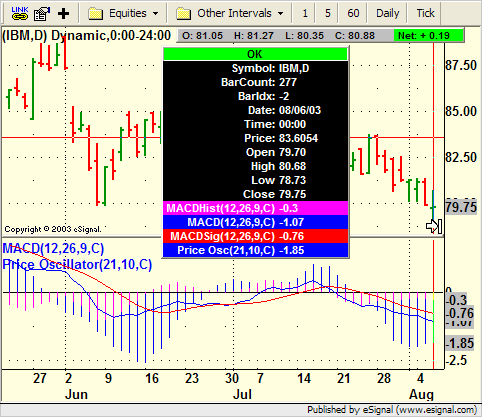I am new to EFS and Formula Wizard. I have been using Metastock real-time w/ a E-signal feed.
In Metastock, all standard formulas must use a "fixed" period in the "periods" field of the indicator. If you have another function that outputs a varying periods calculation (e.g., based on changing volatility), their standard formulas won't read them. You can put most anything (varying or fixed) in the data array reference field, but not the period field. I had to end up getting dlls written to handle this. That is no easy trick since they don't even have development partners "lined-up" to help. That is why I am thinking about switching to EFS.
If I have a custom EFS that outputs a varying period, (e.g., bar #20 = 15, bar#21= 16, bar #22=14, etc) will the standard formulas in E-signal's formula language (e.g., moving average) allow me to read in this so that each bars indicator output is calculated based on "that" bars varying period and retained, that is bar20 calculates a MA based on 15 length & retains it, next bar[bar21] "that" bar's MA is calculated based on 16 length & retained --- by retained I mean each calculation is kept and pieced together in the plot. In other words, it doesn't retroactively recalculate the MA for all past bars based on the current bar's new "period" input.
OR
will I have to get custom EFS to read in my varying periods , and will formulas accept most any data array (e.g., another custom indicator as input, not just High Low Close,etc)?
Thank you
In Metastock, all standard formulas must use a "fixed" period in the "periods" field of the indicator. If you have another function that outputs a varying periods calculation (e.g., based on changing volatility), their standard formulas won't read them. You can put most anything (varying or fixed) in the data array reference field, but not the period field. I had to end up getting dlls written to handle this. That is no easy trick since they don't even have development partners "lined-up" to help. That is why I am thinking about switching to EFS.
If I have a custom EFS that outputs a varying period, (e.g., bar #20 = 15, bar#21= 16, bar #22=14, etc) will the standard formulas in E-signal's formula language (e.g., moving average) allow me to read in this so that each bars indicator output is calculated based on "that" bars varying period and retained, that is bar20 calculates a MA based on 15 length & retains it, next bar[bar21] "that" bar's MA is calculated based on 16 length & retained --- by retained I mean each calculation is kept and pieced together in the plot. In other words, it doesn't retroactively recalculate the MA for all past bars based on the current bar's new "period" input.
OR
will I have to get custom EFS to read in my varying periods , and will formulas accept most any data array (e.g., another custom indicator as input, not just High Low Close,etc)?
Thank you




Comment